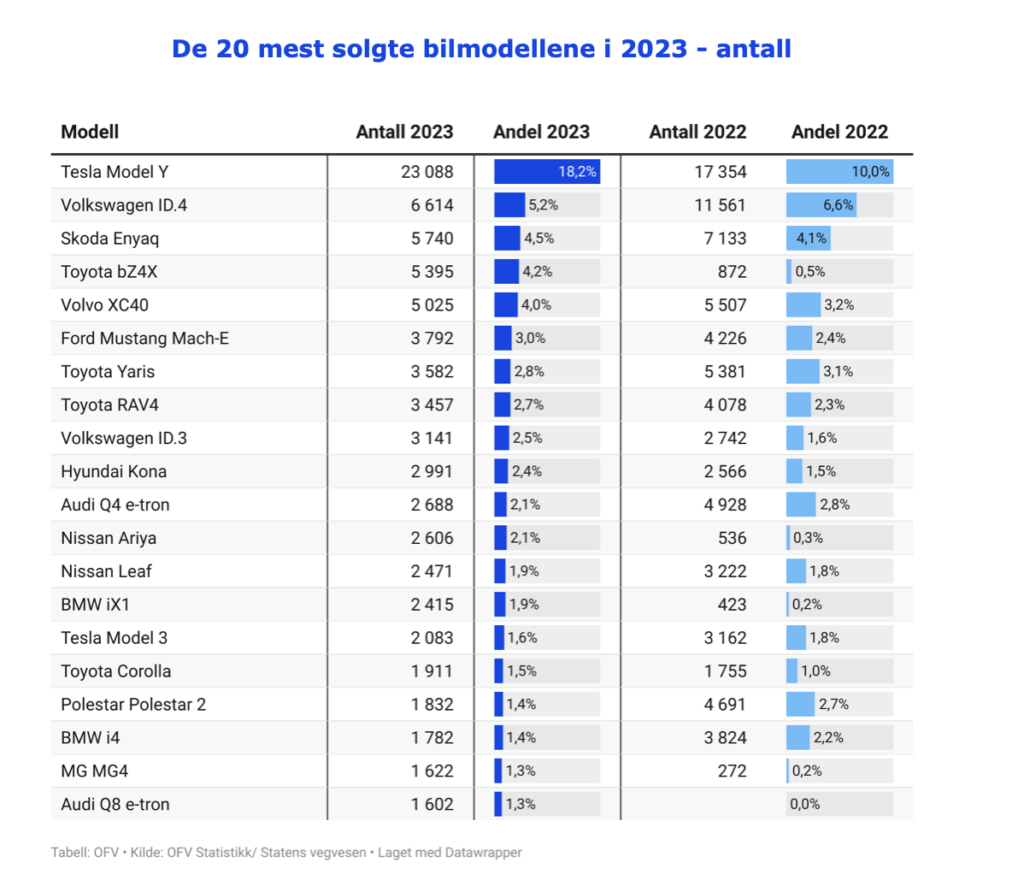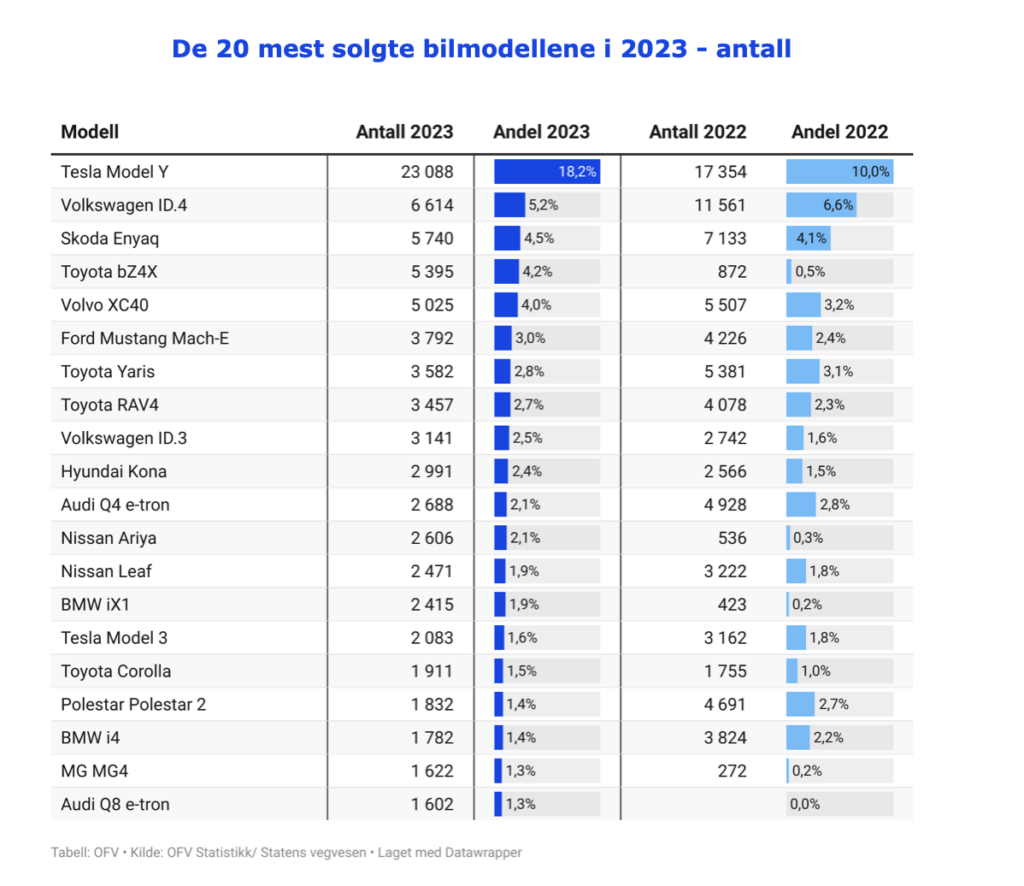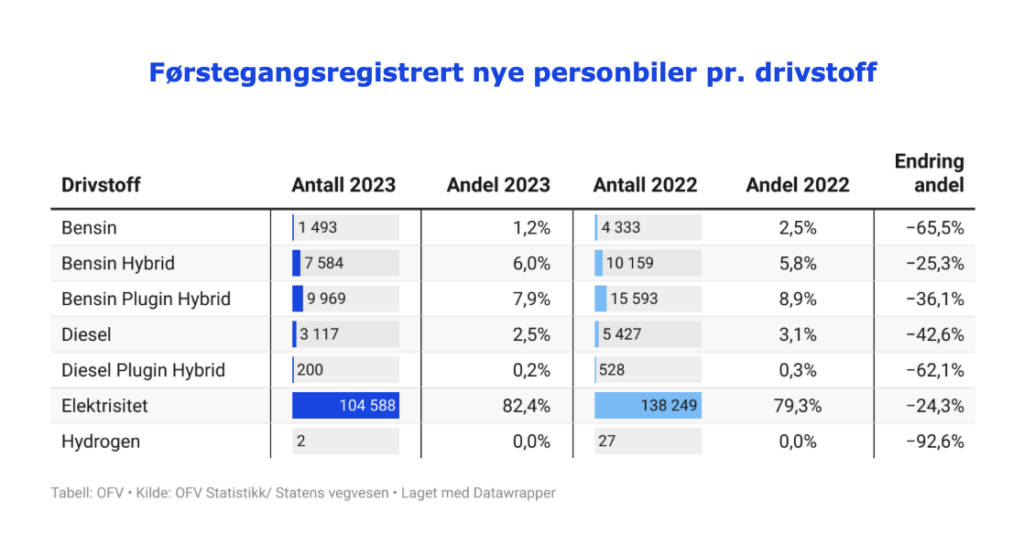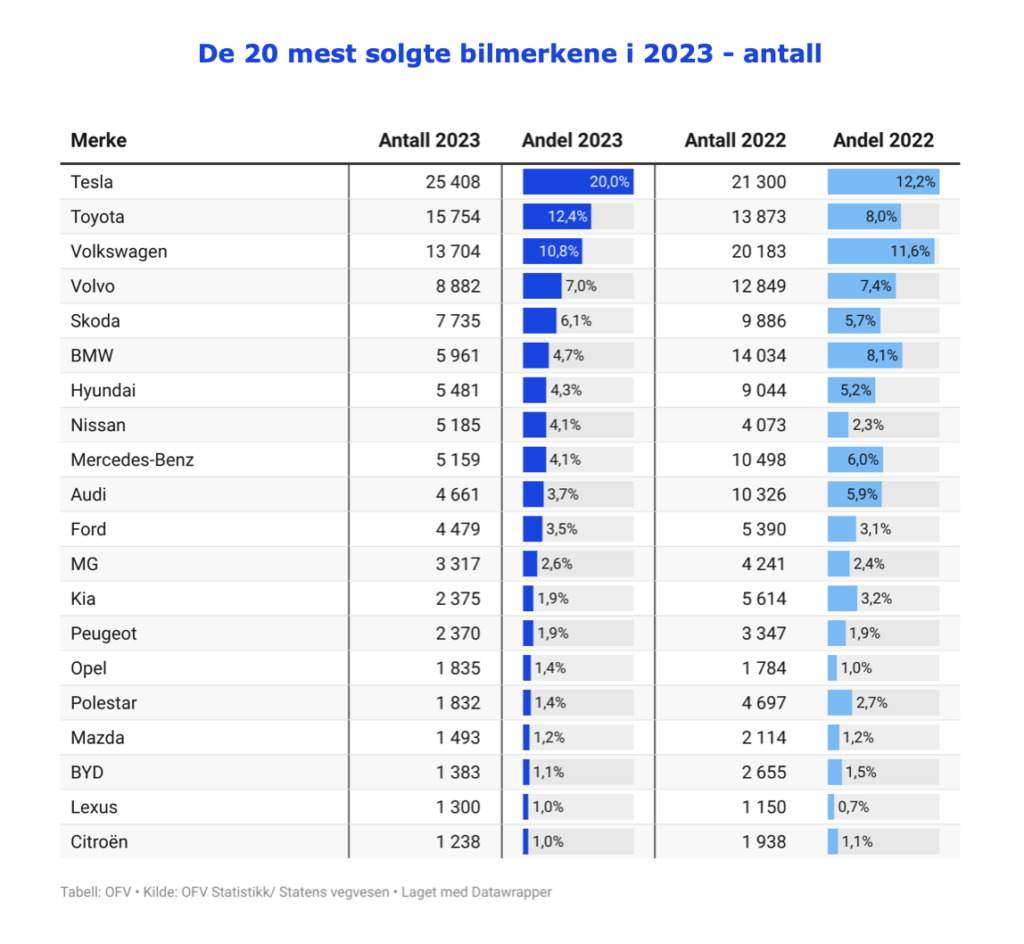The year 2023 was a real cold shower for the car industry and for the goal of replacing the car fleet with zero emissions: The number of first-time registered new passenger cars ended up at 126,953 – a whopping 27 percent behind 2022. And while December 2022 set a new registration record for a single month with 40,000 new cars , December 2023 ended a whopping 69 percent behind the same month the previous year.
The main reason for the registration record in December 2022 was the announced introduction of VAT on electric cars over half a million kroner as well as the introduction of a new weight tax for all passenger cars from 1 January 2023. At the same time, delivery of new cars really picked up speed. Looking at 2023, the new fees came on top in a year of strong price increases and several interest rate hikes. Overall, this had a strong impact on new car sales in 2023, says director Øyvind Solberg Thorsen of the Information Council for Road Traffic (OFV).
Stable share of electric cars – and many choose hybrids In summary, 2023 ended with 126,953 first-time registered new passenger cars, just over 47,000 fewer new cars than the previous year, and a decrease of 27.2 per cent. Although the proportion of electric cars ended at 82.4 per cent, and remained fairly stable at that level throughout the year, the number of cars is lower than before and slows down the transition to an emission-free passenger car fleet.
In December 2023 alone, 12,183 new passenger cars were registered. That is just over 27,000 fewer than in the same month in 2022 – a decrease of 69.2 per cent.
There are still a good number of people who would like to have plug-in hybrids and hybrids with a petrol engine. Collectively, these car types accounted for almost 14 percent of new car registrations in 2023. The plug-in hybrids received a sharp tax increase in 2023, which has meant a decrease in the number compared to 2022. New plug-in gasoline hybrids ended at 9,969, which was 36.1 percent fewer than the previous year.
The phasing out of pure petrol and diesel cars continues, and in 2023 the traditional powertrains ended up at 4,610 cars and 3.7 per cent of the total new car registrations. That’s the lowest number we’ve ever seen.
Tax changes had a big impact 2023 became a clear example of how changes and increases in car taxes control new car sales. A challenging economy caused many to cancel or put the purchase of a new car on hold. The question is whether the politicians did not take a slightly too sharp turn with their new electric car taxes, because it will be hard to reach the goal that all new passenger cars must be emission-free from 2025. To catch up on all the last 17-18 percent in less than a year, becomes challenging, says Solberg Thorsen. And although the proportion of electric cars will probably continue to increase in 2024, at the current pace of the new car market, it will take longer than desirable to replace most of the petrol and diesel cars to zero emissions.
Very low order intake There is great excitement about what will happen to new car sales in 2024. Many importers and dealers are concerned, and have already reported very low order intake at the start of the new year.
While December 2022 produced an “all time high”, January 2023 produced an “all time low”, ending with less than 1,900 new passenger cars. It was the lowest January number for first-time registered new passenger cars since 1962. And there has never been such a big drop from one month to the next, says Solberg Thorsen.
But there is reason to be concerned about the low interest in buying a new car that we are seeing now. The high level of interest rates and tightening of loan regulations have a strong impact on new car sales, and the last thing the market needs is even higher car taxes if we are to achieve the green shift.
Well-known brands top There are well-known car brands that dominate the first five places in the registration statistics for new cars in 2023: Tesla had a superb first place, while Toyota, Volkswagen, Volvo and Skoda also have strong positions in people’s choice of new car.
Although in recent years there have been a large number of new brands and models, we see that most people choose car brands they have a relationship with before, or that they know, when economic times become tougher. Many newcomers therefore struggle to get a hold of customers, says Solberg Thorsen.
But big changes can happen here, because there will be a number of smaller electric car models in the future, several of which will come from new car manufacturers. The new small electric cars will probably also have a favorable price level for many, and it will be exciting to see how this plays out in relation to brands and models in 2024.
Over 500,000 changes of ownership While new car sales have been difficult in 2023, the used market was at full speed. There were approximately 507,000 passenger cars that changed hands, and that is exactly on par with the previous year. Diesel cars, of which there are also the most in the car stock, still dominate the used market with 41 per cent of ownership changes. At the same time, the number of electric cars in the stock is increasing, and these made up a whopping 19 per cent of all changes of ownership last year.
-The decline in new car sales at the same time as there is a steady pace in used car sales shows that many people either keep the car they already have, or choose a used car over a new one. Electric cars are also attractive in the used market, and for many a good alternative to buying brand new. The number of changes in ownership of electric cars in 2023 was 6.3 per cent higher than the previous year, and almost one hundred thousand electric cars changed hands, says Solberg Thorsen.
Van sales slightly up in 2023 The number of new vans registered for the first time increased by 1.3 per cent in 2023, compared to 2022. A total of 28,673 new vans were registered. Of these, the diesel share was 67 per cent, while electric vans had a share of 31 per cent. There is an increase of 6.7 percentage points for electric vans compared to 2022.
The offer of electric vans is constantly improving. But the usability is not yet good enough to meet the needs of many traders. It is about price, range and other important factors for this group. The loss of the Enova subsidy for the purchase of electric vans came too soon, says Øyvind Solberg Thorsen of OFV, who urges the government and Enova to reintroduce the subsidy and let it last until 2025. This will help us get closer to the zero emissions target in 2025, which also includes light vans.
Source: OFV




